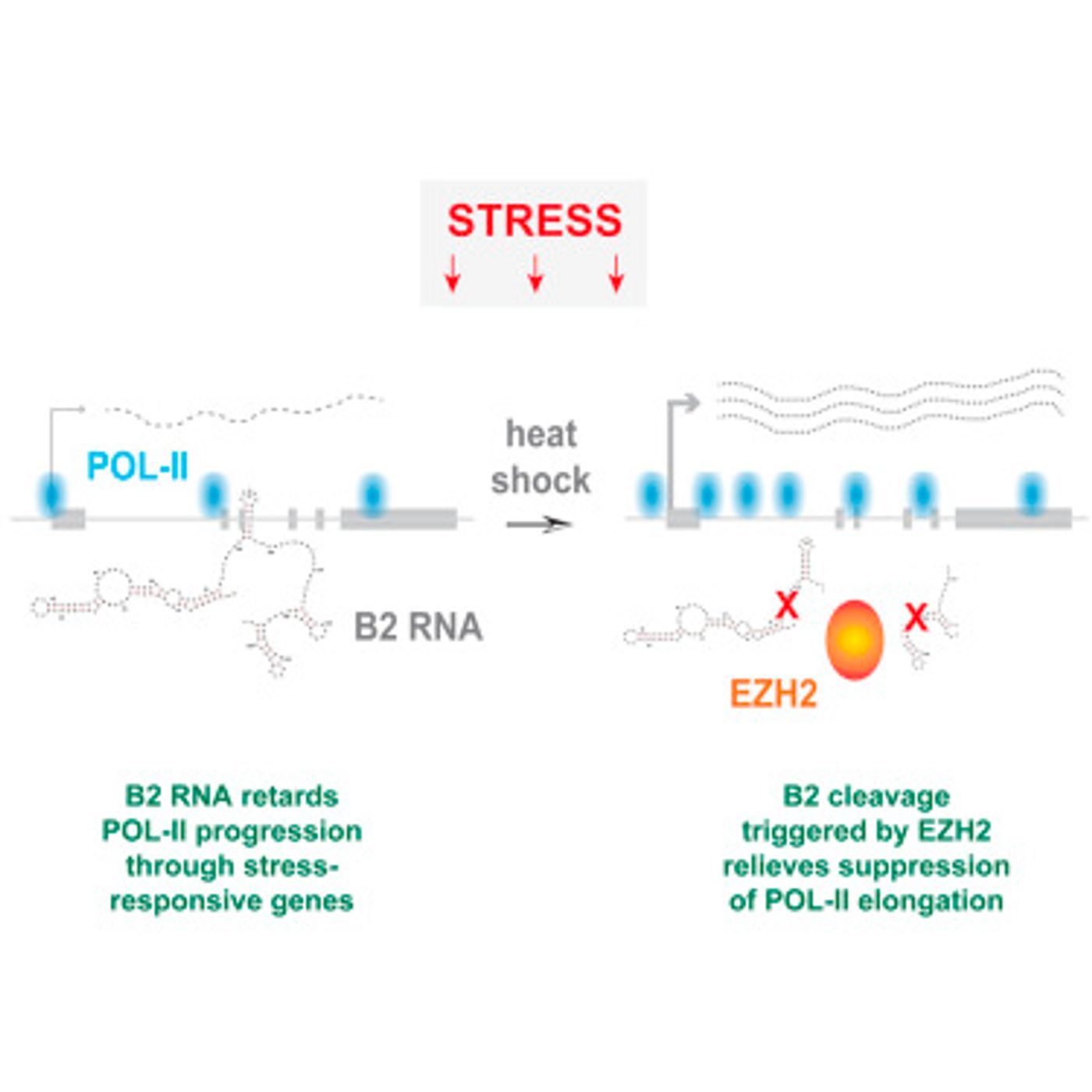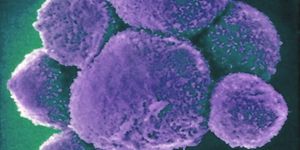"Junk" RNA has a Functional Role in Cell Stress Response
There are vast swaths of genomic regions that don’t code for protein, once nicknamed and thought of as junk DNA and RNA. It is now understood that many of these regions do have roles after all, and the research interest has focused on non-coding DNA regions that are made into RNA. The effects and functions of these non-coding RNAs are still being deciphered. Researchers at Massachusetts General Hospital (MGH) have now reported in Cell that an enzyme called EZH2, an enzyme thought to only stop gene expression, interacts with B2 RNA. The researchers found that very specific interaction to induce stress response genes to express in mouse cells. The graphical abstract for the work is seen below.
"EZH2 is part of a structure called the Polycomb Repressive Complex 2, which silences target genes," explained the senior author of the report, Jeannie T. Lee, MD, PhD, of the MGH Department of Molecular Biology. "But a big paradox in the field has been that EZH2 is found at the sites of both active and inactive genes. We have shown, for the first time, that EZH2 can act outside of the PRC2 complex to activate genes through another mechanism—in this case by cleaving the B2 RNA molecule, which then activates stress response genes."
This research may help shift that opinion that most noncoding RNA does not perform any function. That has held fast particularly for long noncoding RNAs and even more so for RNA that comes from retrotransposons, repetitive DNA sequences that can change their positions and appear throughout the genome. However, recent studies in mouse cells have demonstrated that RNA transcribed from the B2 retrotransposon can suppress the expression of stress genes by binding to them.
Members of Lee's team have previously identified over 9,000 nuclear transcripts that bind to EZH2. Their previous research also suggested that some RNAs, including molecules transcribed from retrotransposons, associate with EZH2, although that relationship was not understood. In this work, the researchers investigated the association in depth to determine more about it, especially whether it is a bona fide interaction. They experimentally confirmed that EZH2 and B2 RNA bind, and that when heat is applied the enzyme cuts the RNA molecule. B2 RNA binds to genes that protect against cellular damage caused by heat, which stops their expression. Cleavage of the B2 RNA enables the expression of those same heat-shock genes.
"Our findings imply that B2 is a key regulator of the stress response and probably has that role in all types of cells," said Lee, a Professor of Genetics at Harvard Medical School. "We and others have studied B2 cells in mice, but these same types of short interspersed nuclear elements are found in human cells, where they are quite different. While it remains to be seen whether human SINEs have similar properties, I wouldn't be surprised if they do."
Future studies aim to find the exact mechanism bringing EZH2 to stress genes, and how it performs the RNA cleavage. The cellular stress response can protect against some kinds of disease and is sometimes purposefully induced therapeutically, such as in the blockage cancer cell proliferation. As such, knowing more about the physiology underlying the cellular stress response is quite relevant to human health.
In this brief video from Foundation for the National Institutes of Health, Lee does a nice job describing her work.
You can read more about non-coding RNA in this piece from Frontiers in Genetics.
Source: Phys.org via MGH, Nature Reviews Neuroscience, Frontiers in Genetics, Cell




![Master Lab Weighing: Accuracy, Compliance & Audits [eBook]](https://d3bkbkx82g74b8.cloudfront.net/eyJidWNrZXQiOiJsYWJyb290cy1pbWFnZXMiLCJrZXkiOiJjb250ZW50X2FydGljbGVfcHJvZmlsZV9pbWFnZV85MWRmZmRjMDIwNDBlMWJjMzYwN2ZiYWY2ZjI4ZGMzYzBmZGMwZGMyXzkxOTcucG5nIiwiZWRpdHMiOnsidG9Gb3JtYXQiOiJqcGciLCJyZXNpemUiOnsid2lkdGgiOjcwMCwiaGVpZ2h0IjozNTAsImZpdCI6ImNvdmVyIiwicG9zaXRpb24iOiJjZW50ZXIiLCJiYWNrZ3JvdW5kIjoiI2ZmZiJ9LCJmbGF0dGVuIjp7ImJhY2tncm91bmQiOiIjZmZmIn19fQ==)




